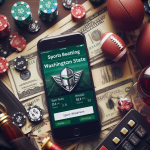Bonus maps are a fun way to make games and apps more exciting. Imagine you are on a treasure hunt, where every step gets you closer to a special prize or bonus. In the world of user experience (UX), bonus maps help to make using an app or game feel just like that adventure. They guide people to discover new features, rewards, or levels, making the experience feel more rewarding and magical.
So, what is UX? UX stands for user experience, which means how people feel when they use a product or service. It is all about making things easy and enjoyable. Now, let’s look at some important terms we will use in this conversation.
First, we have “game mechanics.” These are the rules and systems that make a game fun and engaging. Next is “engagement.” This means how much a user is involved and interested in something. When people are engaged, they want to keep playing or using the app. Then there is “reward system.” This is what gives users something special for their effort, like bonus points or unlockable levels.
Bonus maps combine these ideas. By using colorful graphics and exciting paths, they lead players to explore different parts of the game. Just like a casino, where people chase after jackpots, bonus maps encourage users to keep searching for treasure. Each time they find a bonus, it feels like they struck gold!
In the end, bonus maps make digital experiences more delightful. They turn ordinary tasks into adventures, keeping users happy, engaged, and always ready for more. Who wouldn’t want to feel like they were on a treasure hunt each time they used their favorite app?
Understanding Bonus Maps
Bonus maps are an innovative concept in user experience (UX) design, especially in the field of digital applications and websites. They incorporate elements that resemble treasure hunts in casinos, which can significantly engage users and enhance their interaction with the platform. Bonus maps act as a visual and interactive guide that rewards users for exploration and achievement within an app or website.
What are Bonus Maps?
Bonus maps are dynamic visual aids integrated into user interfaces that encourage users to explore content, complete tasks, or achieve certain goals. These maps often feature gamification elements, such as:
- Interactive elements that respond to user actions
- Rewards systems that unlock bonuses or prizes
- Visual progress indicators
In essence, they transform user navigation into an engaging experience, making it feel like a treasure hunt. Users can follow paths on the map that lead them to rewards, encouraging them to spend more time on the platform while discovering its features.
Key Terms Explained
- User Experience (UX): The overall experience a user has while interacting with a product or service, particularly in terms of how enjoyable or intuitive it is.
- Gamification: The application of game-design elements and principles in non-game contexts to enhance user engagement.
- Digital Interface: The point of interaction between the user and a digital device, which includes websites and applications.
The Problem with Traditional UX
While many interfaces aim to provide straightforward navigation, they often lack the engaging components that keep users interested. Traditional designs can be monotonous, leading to decreased user participation and retention. According to a study, “engagement is actually a faster path to retention than the quality of the products alone.”
Challenges in User Engagement
- Low user retention rates
- Limited exploration of app features
- Difficulty in motivating users to complete tasks
As a result, users often abandon applications before fully experiencing their benefits. This leads to a need for more compelling designs that capture attention and hold interest.
How Bonus Maps Address These Problems
Bonus maps can address many engagement challenges by incorporating visually stimulating elements that create excitement. By rewarding users for exploration, platforms can enhance their retention rates and encourage continued use.
Benefits of Bonus Maps
- Increased User Engagement: By providing a visual representation of achievements, users feel compelled to explore further.
- Enhanced User Motivation: Users are more likely to complete tasks when they have clear rewards outlined on their bonus map.
- Improved Navigation: Bonus maps can simplify pathways through content, guiding users to areas they may overlook.
“When users feel they are in a game-like environment where rewards are achievable, they are far more likely to remain engaged.”
Implementing Bonus Maps
To successfully integrate bonus maps into a platform, designers should follow a few key strategies:
- Identify User Goals: Understand what users want to achieve and create a map that facilitates these goals.
- Design Eye-Catching Graphics: Use visually appealing designs that capture user attention.
- Incorporate Feedback Loops: Provide real-time responses to user actions to create a satisfying user experience.
Real-World Examples
Several applications have successfully used bonus maps to enhance user experience. For example:
| Fitness Apps | Progress tracking maps showing milestones | Motivates users to reach fitness goals |
| Gaming Platforms | Exploration maps revealing game secrets | Encourages more thorough game exploration |
| Shopping Apps | Rewards maps for completing purchases | Increases customer loyalty |
Future of Bonus Maps in UX Design
The future of UX design is likely to see an increasing integration of bonus maps as more companies recognize the value of gamification and user engagement. As technologies evolve, designers will find new and innovative ways to implement these maps, leading to highly personalized user experiences that feel rewarding and interactive.
“Creating an experience that feels like a game can significantly boost user interaction and retention.”
In summary, bonus maps represent a unique approach to enhancing user experiences by transforming traditional navigation into an engaging, game-like journey. As designers continue to innovate and refine these concepts, the potential for increased user satisfaction and loyalty is significant.
What are Bonus Maps?
Bonus Maps are interactive features in games that provide additional challenges and rewards, giving players a sense of adventure similar to a treasure hunt.
How do Bonus Maps enhance user experience?
Bonus Maps enhance user experience by creating an engaging environment where players can explore, discover hidden treasures, and complete quests, which adds an element of excitement and motivation to gameplay.
What kind of rewards can players expect from Bonus Maps?
Players can expect various rewards such as in-game currency, special items, and unique achievements that can enhance their overall gaming experience and progression.
Are Bonus Maps similar to real-life treasure hunts?
Yes, Bonus Maps are designed to replicate the thrill of treasure hunts by encouraging exploration and offering rewarding surprises, similar to how players would seek treasures in real-world scavenger hunts.
Can every player access Bonus Maps?
Access to Bonus Maps may vary based on the game design; some games may require specific levels, achievements, or purchases to unlock these features for players.
How do Bonus Maps motivate players?
JAW-DROPPING JACKPOT IN LAS VEGAS! #casino #slots #lasvegas
By combining elements of chance and strategy, Bonus Maps motivate players to invest more time and effort in the game in hopes of uncovering valuable treasures and completing challenging objectives.
What types of games commonly feature Bonus Maps?
Bonus Maps are commonly found in role-playing games (RPGs), adventure games, and mobile games that focus on exploration and reward systems.
How often are Bonus Maps updated?
Updates for Bonus Maps can vary by game; some games may have seasonal updates or regular events that introduce new maps, challenges, and rewards to keep the gameplay fresh and exciting.
Are there any strategies for successfully navigating Bonus Maps?
Players can enhance their chances of success by carefully exploring each area, paying attention to clues, and strategizing their moves to unlock all treasures and complete tasks efficiently.




